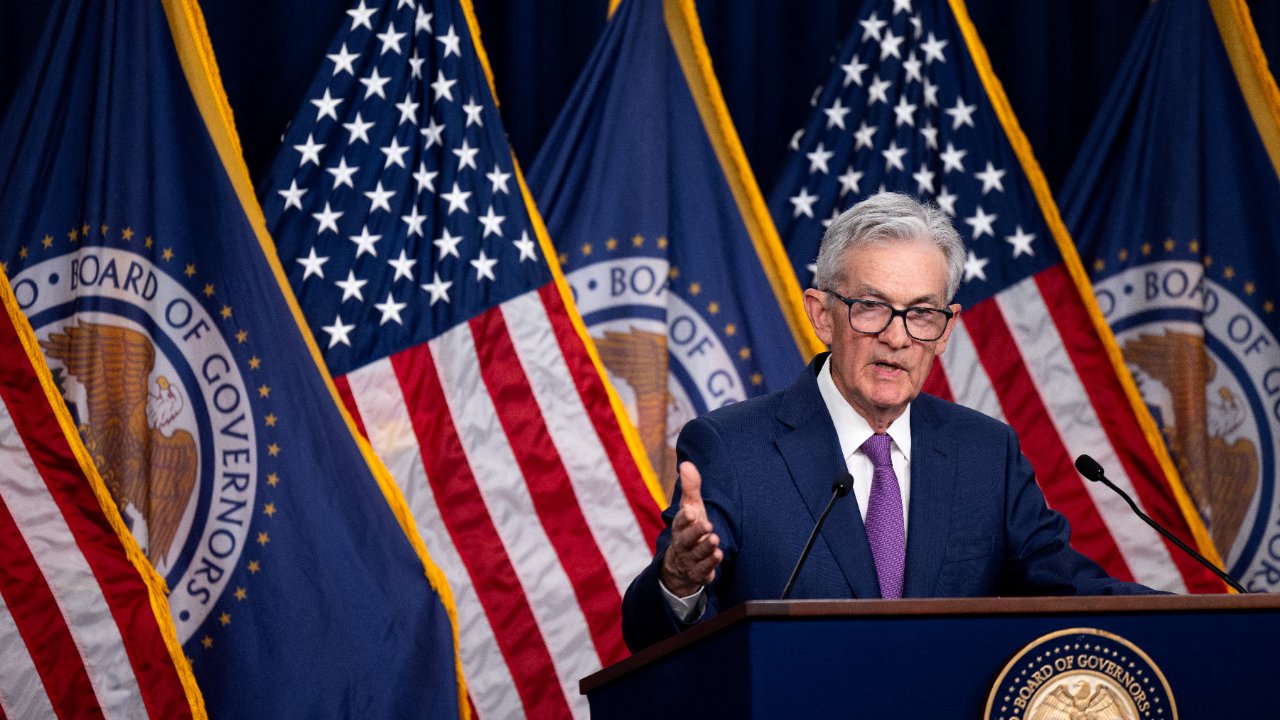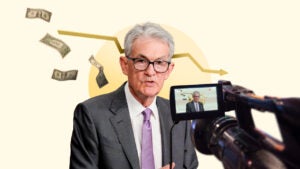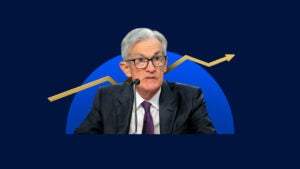Fed remains on hold, keeps forecast for three rate cuts in 2024

The Federal Reserve left interest rates unchanged for the fifth straight meeting and signaled that they still plan to cut interest rates three times in 2024, even as recent data suggests that inflation has been more stubborn than expected.
The Federal Open Market Committee’s (FOMC) latest decision means the Fed’s key benchmark interest rate will not move from its current target range of 5.25-5.5 percent, a 23-year high.
Like a pebble creating ripples as it skips through a pond, the Fed’s announcement matters because it influences the amount of interest a consumer pays to borrow money. On the list of key borrowing costs that move in lockstep with the Fed are adjustable-rate mortgages, auto loans and, to some extent, the 30-year fixed-rate mortgage, all of which have been holding at the highest levels in more than a decade as the Fed has rushed to slam the brakes on the economy. Credit card rates, meanwhile, have never been as high as they are now, according to rate data that Bankrate tracks.
Fed officials think they’ll be able to cut borrowing costs eventually this year, but they’re cautious about giving the financial system more gas, too soon. The U.S. central bank closed out 2023 on a high note: Inflation slowed faster in the year than officials had initially expected, recent data from the Department of Commerce shows.
Yet, the consumer price index (CPI) is showing that inflation isn’t slowing as quickly as it once was. Price pressures have been in a holding pattern around 3 percent for four months, validating Fed Chair Jerome Powell’s claims that the final mile of bringing inflation down to their ultimate 2 percent goalpost could be the hardest.
“We’re not going to overreact to these two months of data, but we’re not going to ignore them,” Powell said at the Fed’s post-meeting press conference. “We don’t really know if this is a bump on the road or something more. We’ll have to find out.”
But a solid economy — which has been dodging recession calls for two years now — has been affording the Fed its patience. The labor market is showing early warning signs of losing steam. Unemployment has held below 4 percent for the longest stretch of time in more than half a century but has been slowly ticking up, hitting the highest level in two years in February. The share of workers voluntarily quitting their positions has also rebounded back to pre-pandemic levels, a sign of decreased confidence in the economy.
Barring a major downturn, economists say the Fed is unlikely to cut borrowing costs aggressively, even when the time for cheaper interest rates does come. Yet, how long the Fed decides to keep rates high will have major implications for every financial decision consumers make.
“We may be getting closer to the first interest rate cut, but it sure doesn’t feel that way,” says Greg McBride, CFA, Bankrate chief financial analyst. “The Federal Reserve needs to see continued improvement in the inflation readings to be confident that it is on track for the target of 2 percent.”
The Fed’s rate decision: What it means for you
Savers
After more than a decade of rock-bottom interest rates, savers have been getting showered with major payouts from the top online banks. Many of the best high-yield savings accounts that Bankrate tracks are paying 5 percent or more a year in interest, the highest annual percentage yields (APY) in more than a decade.
On an FDIC-insured account, that’s a market-like return without any market risk. It translates to big earnings. Keeping $10,000 in an account with a 5 percent APY would yield a saver $500 in just a year, assuming rates stay at that level, Bankrate’s savings calculator shows. Savings yields are variable and have already been edging lower as the Fed looks likely to cut borrowing costs this year. Back in October, the highest-yielding 5-year certificate of deposit (CD) topped 4.85 percent. As of March 20, it’s fallen to 4.55 percent.
Don’t get too disappointed. Modest rate cuts coupled with slowing inflation mean that banks are likely to continue paying yields that outpace inflation. The margin between the inflation rate and your APY is what matters most, as it indicates whether your purchasing power is actually growing. The wider the margin, the greater the “real” return on your money will be.
If you’re primarily saving for emergencies, yield-chasing shouldn’t be your ultimate priority, but you’ll still want to prioritize keeping your cash in a high-yield account versus at a traditional brick-and-mortar bank. The nation’s biggest banks from Chase to Bank of America are paying 0.01-0.03 percent APY a year in interest. The right account can help you grow your rainy day fund even faster.
Meanwhile, if you can afford to lock away some cash, the Fed’s delayed rate cuts mean it might be a wise idea to complement your portfolio with a CD.
Borrowers
Borrowers are hurt the most in a high-rate environment, especially those with high-cost credit card debt. Financing a big-ticket purchase with plastic was never cheap, but it’s even more burdensome today, as the average rate sits at 20.75 percent, Bankrate data shows. Retail cards come with even higher interest rates near 29 percent.
Americans hoping to get rid of their debt can find balance-transfer cards with 0 percent introductory annual percentage rates (APRs) that currently last as long as 21 months. There’s no benefit to waiting, as the money saved on interest could translate to hundreds, if not thousands, of dollars, all while helping you speed up your debt repayment.
But the unexpected can happen, regardless of the rate environment. High-rate environments can be especially painful for the Americans who have no choice but to take on costlier debt, after a car breaks down or a roof leaks. Stay extra focused on your credit score — make your payments on time and utilize no more than 30 percent of your available credit — to help ensure you’re eligible for lenders’ best rates. Be sure to compare offers from multiple lenders, too, to ensure you’re not missing out on a higher interest rate. And if you can afford to wait, lower rates down the road mean it’s a wise time to think twice about financing a big-ticket purchase right now.
Homebuyers
No one knows the pain of higher interest rates more than the Americans who’ve been sitting on the sidelines, waiting for the chance to buy their first home.
Financing $500,000 on a 30-year fixed-rate mortgage currently would cost roughly $3,300 a month in principal and interest, 59 percent more a month than it did back when rates were at a record low in 2021, Bankrate’s mortgage data and calculators show. Higher financing costs require more income and more documentation, making it harder for Americans to qualify for loans — and find housing that fits in their budget.
But the Fed only indirectly influences mortgage rates, as the ultimate determinant of what happens with the key home-financing rate is inflation. Stubborn price pressures have caused the 10-year Treasury yield — the benchmark for the 30-year fixed-rate mortgage — to bounce higher over the first three months of 2023, interrupting the retreat in mortgage rates at the end of last year. Yet, the opposite can also be true. More good news on inflation will weigh on mortgage rates, meaning the price of financing a home can get cheaper long before the Fed cuts interest rates.
McBride predicts that the 30-year fixed-rate mortgage will fall to 5.75 percent by the end of the year, according to his 2024 interest rate forecast.
That’s still higher than at any point since the Great Recession, but the savings could be significant. That same $500,000 mortgage would cost roughly $2,900 a month, translating to nearly $5,000 in annual savings.
But rates aren’t the only factor pummeling would-be homebuyers. Low inventory is continuing to keep a floor on how much home prices can fall. Lower mortgage rates could unlock more supply, especially if it entices sidelined homeowners to give up their current mortgage rate. Yet, experts question whether buyers may be willing to trade a sub-3 percent mortgage rate for one closer to 6 percent.
Americans can still take steps that set them up for homeownership in today’s difficult market. Bolster your income, pay down your debts, improve your credit score and save for a down payment, so you’re ready to buy a home when the market is working in your favor.
Investors
Investors have been suspiciously chipper, with the S&P 500 breaking 18 record highs nearly four months into 2024 — even as it looks likely that the Fed will be nowhere near as aggressive with cutting interest rates as they first expected. At the end of 2023, investors expected seven rate cuts, far outnumbering the three that officials penciled in. Two months of stronger-than-expected inflation data have walked back those expectations, with investors now seeing just three cuts in the year ahead.
But markets can get volatile in an instant, especially if the surprisingly resilient U.S. economy looks like it’s turning a corner. But if you’re investing for at least five years, don’t let the latest boogeyman of the data get to you. It’s especially important that you stay the course with your retirement savings, seeing downdrafts in the market as a powerful buying opportunity. Meanwhile, keeping a diversified portfolio is the best way to protect yourself against the risks of the market.
Rate cuts and balance sheet changes are on deck, but when?
At the Fed’s March meeting, officials updated their quarterly projections for where they expect interest rates, inflation, the labor market and economic growth to head in the year ahead.
Those estimates showed that officials still expect to cut borrowing costs three times this year, though fewer officials expect that the Fed will get more aggressive than that as inflation stays stubborn.
In December, four officials estimated that they’d be able to cut borrowing costs by a full percentage point this year. As of the Fed’s latest update, just one official still sees that many cuts coming to fruition. Meanwhile, one official in December estimated an aggressive 1.50 percentage points worth of cuts — a forecast that not a single official shares today.
Officials kept three cuts on the table even while simultaneously upgrading their forecasts for growth and the labor market in 2024. Fed officials see unemployment hitting 4 percent, inflation sticking at 2.4 percent and the U.S. economy expanding 2.1 percent for 2024.
“In and of itself, strong job growth is not a reason for us to be concerned about inflation,” Powell said. “If we ease too much or too soon, we can see inflation come back, and if we ease too late, we can do unnecessary harm to employment and people’s working lives.”
Powell said cuts could come “at some point this year,” stopping short of saying whether the Fed’s first cut could come at its next meeting in May or June. The takeaway, however, is that the latest inflation data hasn’t harmed their confidence that the economy is getting back on track.
“They haven’t really changed the overall story,” Powell said of the latest figures, “which is that of inflation moving down gradually on a sometimes-bumpy road toward 2 percent. … This is why we are approaching this question carefully.”
Another key part of the Fed’s post-pandemic monetary policy, officials have been shrinking their bond portfolio by up to $95 billion a month — but the time for reducing that pace could be coming “fairly soon,” Powell said.
The decision matters because the Fed’s shrinking balance sheet influences the money supply. Less money and credit in an economy can be another driving factor pushing up interest rates in the marketplace. And if the Fed ultimately ends up shrinking the money supply too much, it can lead to disruptions in key corners of financial markets — preventing the Fed from shrinking its balance sheet as much as it ultimately wants to.
“Slowing the pace of run-off will help ensure a smooth transition, reducing the possibility of money markets experiencing stress,” Powell said. “We may actually be able to get to a lower level because we would avoid the kind of frictions that can happen.”






